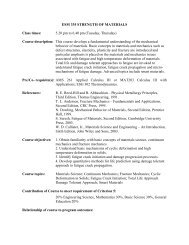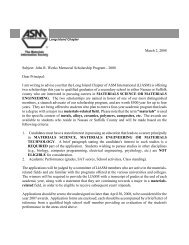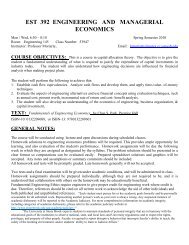PHY 131E Classical Physics I (Required) - Materials Science and ...
PHY 131E Classical Physics I (Required) - Materials Science and ...
PHY 131E Classical Physics I (Required) - Materials Science and ...
You also want an ePaper? Increase the reach of your titles
YUMPU automatically turns print PDFs into web optimized ePapers that Google loves.
<strong>PHY</strong> <strong>131E</strong> <strong>Classical</strong> <strong>Physics</strong> I (<strong>Required</strong>)<br />
Course Catalog description:<br />
An introductory survey of mechanics, wave motion, kinetic theory, <strong>and</strong> thermodynamics. Calculus is used<br />
concurrently with its development in MAT131C Calculus I.<br />
3 credits<br />
Pre- or Corequisite(s): MAT 125C Calculus A or MAT131C Calculus I or MAT141C Honors Calculus I<br />
or MAT126C Calculus B or AMS151C Applied Calculus I or level 5+ on the mathematics placement<br />
examination; <strong>PHY</strong> 133 <strong>Classical</strong> <strong>Physics</strong> Laboratory I<br />
Text(s) or other required material:<br />
Douglas C. Giancoli, <strong>Physics</strong> for Scientists & Engineers, Pearson Ed./Prentice Hall, 4 th edition, 2008,<br />
ISBN: 0-13-227359-4. Scientific Calculator.<br />
Course learning outcomes:<br />
Ability to analyze a situation or a problem: visualize the situation, identify the constraints <strong>and</strong> the variables;<br />
identify the physics in a problem, <strong>and</strong> to re-state the problem in terms of the physics variables <strong>and</strong><br />
mathematical equations. Ability to argue if a solution is, or is not possible in principle. Ability to use<br />
mathematical tools to find the solution. For the <strong>Classical</strong> <strong>Physics</strong> I course, the problems <strong>and</strong> situations deal<br />
exclusively with Newtonian mechanics <strong>and</strong> thermodynamics of solids, fluids, <strong>and</strong> gases. Ability to make<br />
order-of-magnitude estimates, <strong>and</strong> to check solutions for correctness using symbols, special-situation<br />
checks, <strong>and</strong> units checking.<br />
Topics Covered:<br />
Units, Physical Quantities, <strong>and</strong> Vectors<br />
One-Dimensional Motion<br />
Two/Three-Dimensional Motion<br />
Circular Motion<br />
Newton’s First <strong>and</strong> second laws<br />
Newton’s third law<br />
Applying Newton’s laws<br />
Friction<br />
Circular-motion dynamics<br />
Work <strong>and</strong> Kinetic energy<br />
Power<br />
Potential Energy<br />
Energy Conservation & Momentum Conservation<br />
Collisions<br />
Rotational motion<br />
Moment of inertia<br />
Torque<br />
Energy <strong>and</strong> Angular momentum<br />
Gravitation <strong>and</strong> Keppler’s Laws<br />
Statics<br />
Harmonic motion<br />
Damping <strong>and</strong> Resonance<br />
Fluids <strong>and</strong> Bernoulli’s Principle<br />
Traveling Waves<br />
Superposition Principle<br />
Sound waves
St<strong>and</strong>ing waves<br />
Doppler effect<br />
Temperature <strong>and</strong> expansion<br />
Heat<br />
Molecular theory of heat<br />
1 st law of thermodynamics<br />
Thermodynamics<br />
2 nd law <strong>and</strong> heat machines<br />
Carnot cycle<br />
Entropy<br />
Class/ Laboratory Schedule:<br />
Fall: Lecture, Monday/ Wednesday/ Friday, 11:45 – 12:40 pm<br />
Recitation, 55 minutes (15 sections)<br />
Spring: Lecture, Monday/ Wednesday/ Friday, 8:30 – 9:25 am<br />
Recitation, 55 minutes (5 sections)<br />
Contribution of Course to meet requirement of Criterion 5:<br />
<strong>Classical</strong> <strong>Physics</strong> contributes strongly to the Program Objectives 1), 2), <strong>and</strong> 3) of the Program Objectives.<br />
Relationship of course to program outcomes:<br />
<strong>Classical</strong> <strong>Physics</strong> I aims to develop the problem solving skills of the students in Newtonian <strong>Physics</strong><br />
situations: problem visualization, identification of the underlying physics processes, variable analysis <strong>and</strong><br />
solution search. Thus, this course contributes strongly to the technical aspects of the physics <strong>and</strong><br />
engineering skills to be acquired by the students.<br />
Person(s) who prepared this description <strong>and</strong> date of preparation:<br />
Michael M. Rijssenbeek, 4 June 2009.







